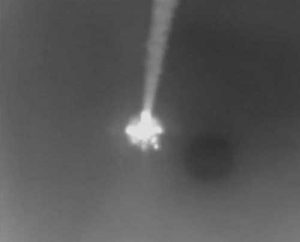
PENTAGON — U.S. President Donald Trump and Pentagon officials are dismissing Russian claims that Syrian air defense systems took out most of the cruise missiles aimed at three of the country’s critical chemical weapons sites.
Russian news outlets Monday quoted the Russian Defense Ministry as saying Syria’s Pantsir-S1 was nearly 100-percent effective in repelling the U.S.-led airstrikes early Saturday.
Defense Ministry spokesman Igor Konashenkov said the Pantsir system launched 112 surface-to-air missiles, shooting down 71 of 103 U.S., British and French cruise missiles.
The Pantsir, sometimes called the SA-22 Greyhound, is a mobile, ground-based system that can engage multiple targets simultaneously. According to the Center for Strategic and International Studies’ Missile Threat Program, it’s surface-to-air missiles have a range of about 20 kilometers.
Despite the claims, Trump and U.S. military officials are standing by their original assessment that all 105 cruise missiles launched by the United States, Britain and France hit their intended targets within just two minutes of each other.[xyz-ihs snippet=”adsense-body-ad”]“They didn’t shoot one down,” Trump said during an appearance Monday in Florida, mocking Russia’s ever-growing claims of success in thwarting the attack. “The equipment didn’t work too well, their equipment.”
“We are confident that all of our missiles reached their targets,” Joint Staff Director, Lt. Gen. Kenneth McKenzie told reporters at the Pentagon Saturday.
“None of our aircraft or missiles involved in this operation were successfully engaged by Syrian air defenses, and we have no indication that Russian air-defense systems were employed,” he said.
U.S. defense officials also say there are no indications Russia’s most advanced air defense system, the S-400, ever engaged any of the incoming cruise missiles, and may not even have been activated.
Of the more than 40 surface-to-air missiles Syria launched in response to the strikes, U.S. officials say the vast majority were fired after U.S., British and French cruise missiles had already hit their targets.
“We assess that the defensive efforts of Syria were largely ineffective, and clearly increased risk to their people based on this indiscriminate response,” McKenzie said, adding, if anything, the Syrian response endangered its own population.
“When you shoot iron [missiles] into the air without guidance, it’s going to come down somewhere,” he said.
Other U.S. officials shared the successful view of the strikes.
“It is clear from those photographs that we’ve seen so far that we’ve been successful,” said a senior administration official. “We’ve seen the facilities and any equipment that was at those facilities has been eliminated.”
The U.S. said all three of the targets – the Barzah Research Center in Damascus and storage and equipment facilities near Homs – were involved in the production and deployment of both chlorine and sarin gas. It said there were no indications any of the chemical agents had been released into the air as a result of the strikes.
Trump said Friday the strikes could be part of a sustained effort if Syrian President Bashar al-Assad continued to use chemical weapons.
On April 14, 2018, the Virginia-class fast attack submarine USS John Warner (SSN 765) launched tomahawk missiles from the Mediterranean Sea as part of a multi-national strike operation against the Syrian government. Video-DoD
On Monday, White House officials held open the possibility more such strikes could be on the way.
“We’re going to continue to keep a number of options on the table if Syria, Russia and Iran don’t show to be better actors in this process,” White House Press Secretary Sarah Huckabee Sanders told reporters traveling with the president en-route to Florida.
Source: VOA
